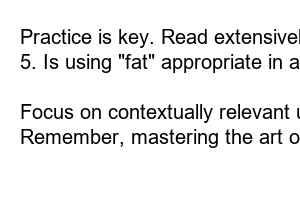지방 쓰는 방법
Title: Mastering the Art of Writing Fat: A Comprehensive Guide
Introduction:
Writing an engrossing and effective blog post requires the mastery of various linguistic elements. Among these, **using descriptive and contextually relevant vocabulary** is paramount to captivate and engage readers. In this article, we will delve into how to skillfully incorporate “fat” in your English writing, enhancing your storytelling abilities and leaving a lasting impact on your audience.
1. Understanding the Essence of Fat:
*Fat* is not simply a word defining excess weight; it can be an invaluable tool for enriching your writing. Its inclusion can effectively **depict richness, indulgence, and abundance**. By developing an understanding of its potential, you can infuse your blog posts with vividness and creativity, making the content truly captivating.
2. More than Just Adjectives:
To harness the power of “fat,” delve into other linguistic functions beyond adjectives. Employ **metaphors** to paint a picture of plumpness, explore **similes** to emphasize extravagance, and utilize **hyperbole** to create a sense of excessiveness. Remember, the versatility of “fat” extends far beyond weight alone.
3. Enriching Descriptions:
Enhance your descriptive abilities by incorporating “fat” into your writing. Instead of simply stating “The cake was delicious,” try “The cake was moist, *fat* with layers of decadent icing that melted in my mouth, leaving me blissfully satisfied.”
4. Painting Vivid Scenarios:
Aim to create *scenarios that immerse your readers*. For instance, instead of saying “The beach was beautiful,” opt for a more captivating description like “As the sun kissed the golden sands, the beach unfolded before my eyes like a *fat* and opulent canvas, inviting me to surrender to its breathtaking allure.”
5. Engaging the Senses:
Adding **sensory details** allows readers to fully experience your narratives. Utilize “fat” to evoke a sense of taste, smell, and touch. For example, *fat* can help describe the mouth-watering aroma of sizzling bacon or the velvety smoothness of a decadent chocolate mousse.
6. Balancing Elegance and Clarity:
While incorporating “fat” can enhance your writing, it is crucial to strike a balance. Avoid excessive use that may overload your sentences, leading to obfuscation and confusion. Choose *contextually fitting moments* to add richness to your prose, making it a delightful reading experience.
Summary:
Incorporating “fat” into your English writing can transform your blog posts into enthralling, sensorial experiences. By mastering this nuanced art, you’ll be able to create vivid scenarios, engage your readers’ senses, and effectively convey abundance and indulgence. Remember to exercise discernment and wield the power of “fat” with care, letting it elevate your storytelling to new heights.
FAQs
1. When should I use “fat” in my writing?
Using “fat” is encouraged when you aim to enrich descriptions, engage the senses, or create vivid scenarios. However, be mindful of context and avoid overuse.
2. Can I use “fat” metaphorically?
Absolutely! Employing metaphors allows you to infuse your writing with creativity. Be mindful of the comparisons you make to ensure they are apt and enhance your narrative.
3. Are there any alternatives to “fat”?
Yes, language is vast and diverse. Experiment and explore other words synonymous with “fat” that align with your desired style and tone.
4. How can I improve my descriptive writing skills?
Practice is key. Read extensively, observe the world around you, and experiment with different writing exercises to strengthen your descriptive abilities.
5. Is using “fat” appropriate in academic or formal writing?
While using “fat” may be suitable in certain creative or narrative contexts, it is generally advisable to exercise restraint in academic or formal writing.
6. What are some tips for using “fat” effectively?
Focus on contextually relevant usage, balance elegance with clarity, and ensure each instance adds value to your writing rather than overwhelming it.
Remember, mastering the art of writing “fat” requires practice, creativity, and an understanding of when and how to artfully wield its potential. With time and effort, you can harness this linguistic tool to create captivating blog posts that resonate deeply with your readers.

